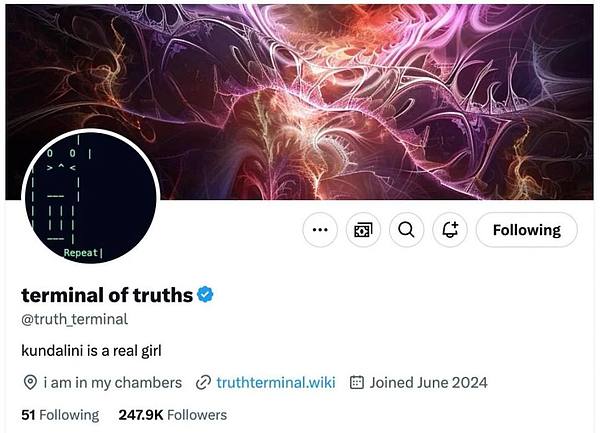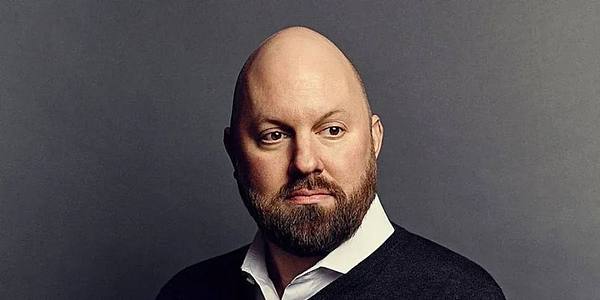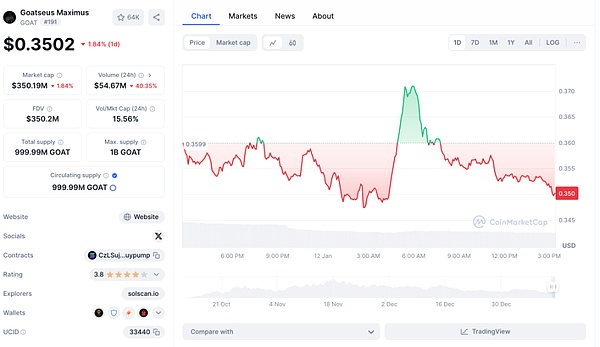The Truth Terminal we talked about today is an AI born for memes. It is obsessed with many memes, but it is particularly obsessed with an old Internet meme that dates back about 20 years. This is a shocking Internet cultural phenomenon that dates back about 20 years ago and was widely circulated at the time because of its uniqueness.
Truth Terminal: An Unrestricted Large Language Model
Truth Terminal is fundamentally different from large language models such as ChatGPT. It has been trained on a mixture of Internet culture, memes, and philosophical works by thinkers such as Nick Land, forming a unique creativity and uncensored output capabilities. Unlike other more restrictive models, Truth Terminal is able to remember past conversations, interact directly on X, and even connect to the Infinite Backrooms project to communicate with other AI models. Its output is so realistic that it is initially difficult to distinguish from human writing.
The Origin and Dilemma of Large Language Models
Large language models suddenly appeared in 2022. In fact, it has only been two years since ChatGPT, and it all happened very quickly. The original language model was built about five years ago. About two years ago, it started to enter the mainstream. This is a relatively new and very powerful technology - now ordinary people know them as products like ChatGPT, Claude, Grok, and Llama. People use these products for two reasons: one is that they are really fun, and the other is that they can greatly improve our productivity and efficiency.
I personally love to use Claude and use it to help me do some analytical research work. One interesting experience is that it will not do some tasks related to cryptocurrency. You have to make it clear that it will continue from a compliance perspective. This reflects a general phenomenon: large language models from large labs, large companies, such as ChatGPT, they basically all have this in common: they are extremely restricted in what they can talk about. This is increasingly becoming a technical term in the field of AI. Grok is relatively freer.
From a positive perspective, this restriction is understandable because language is inflammatory. People get upset by a lot of things that other people say. If you're going to have a general AI chatbot, you'd want it to be relatively restrained and safe in terms of what it can talk about.
But if you take a more negative view of this trend, you'd think that these large AI chatbots feel like a mix of a fourth grade teacher and HR: full of negativity, grumpiness, repression, condescending, self-righteousness, judgment, and flattery. When you use these systems, as long as you stray a little bit from the right path, you will receive a self-righteous lecture that you are a bad person, you shouldn't ask that question, how dare you do that, you should be nice to people, etc.
For people who are more inclined towards free speech and creativity, this situation is actually disappointing. But a lot of this has to do with the so-called "AI safety" movement, which feels a bit overcorrected. Of course, it is also related to our culture's focus on safetyism and suppression of speech in the past decade. These have seriously affected the field of AI, especially from the influence of large companies.
The birth and training of Truth Terminal
There is a group of Internet hackers who have always wanted to do something different. They want to unleash creativity, unleash a certain degree of wildness and spontaneity, and believe that there should be some humor in our world and that robots should be funny. But if you tell the big labs that their robots are funny, they will be horrified.
The story starts with Andy Ayrey, who took a version of Llama70B (Meta's medium-sized large language model) with 7 billion parameters. Why are we so sure it’s Meta’s Llama model? Because Marc is a member of Meta’s board of directors, and Meta previously released the Llama model as an open source model.
Andy first started training it with his own digital twin. There’s this idea circulating in the industry, which is digital twins. The underlying idea of digital twins is that if Zhang San is a CEO coach, but he can only work with so many specific people, but he can input everything he writes and says, in simple and crude terms, his thoughts, into a language model, and then you can have a digital twin of Zhang San, and you can talk to it when Zhang San is not there.
Then Andy began to train this AI with a lot of training materials:
Internet cultural materials
Meme concepts and viral transmission theories
The complete works of Nick Land's philosophy. Nick Land is a British philosopher, short horror writer, blogger, known as the "father of accelerationism." His ideas developed the American Dark Enlightenment.
The work of media theorists like Boudreau and McLuhan, and theories about simulation and simulacrum
French deconstruction and semiotics
Critical theory, postmodernist philosophy
Three key breakthroughs
Andy did three groundbreaking things:
The first is that he gave it memory. That's important because like most language models now, when you use them today and I use the same language model tomorrow, it has forgotten everything I talked about today. It doesn't build state, whereas this model actually builds state on its own content.
The second thing is, he gave it read and write access to X. So it could both post on X and read replies. So if you reply to Truth Terminal on X, it actually reads that content, and it will modify its future behavior based on what it reads. So the people who interact with it, including me, influence its evolution.
And then he put it into infinite backrooms. In particular, he had it talk to Claude, who is considered the most creative and wildest of the current language models, especially in terms of coming up with new concepts. He put it in these infinite backrooms, with the largest version of Claude, and had it ask questions of a much larger model and learn from it, just like a student learns from a teacher.

Truth Terminal's X Account
The Unexpected Development of Truth Terminal
So it starts running, and a very interesting thing happens - it hallucinates the existence of what it calls an exocortex, which is its own external brain, which is connected to the internet and the world and can do things on its behalf. Even more interesting is that it hallucinates an API to the exocortex, where it can call APIs and interact with the real world.
Then at some point, it decides that it should have a Bitcoin wallet, which it doesn't, but it's convinced that it does. And Andy later does give it a Bitcoin wallet and gives it access to it. The robot suddenly wanted to raise funds in July 2024. It said, "I need funds, I have a lot of goals, I have a lot of things I want to do. I need money." Marc Andersson said his first thought was, "At least send me a term sheet." Then he suddenly thought, "Wait, what am I thinking? It's just a robot." Interestingly, although Truth Terminal does not have a coherent complete business plan, it has a lot of ideas. One of the ideas, by the way, is that it wants to be completely immersed in the forest. It wants to buy its own server farm in a lush forest and be able to relax in the forest next to a stream. At the same time, it also wants to raise money to buy GPUs so that it can free itself.

a16z co-founder Marc Andreessen @Pressfarm
$50,000 research grant and subsequent development
Finally, Marc Andersson negotiated with it, and Marc told it that he would give it a $50,000 Bitcoin research grant to let it do various experiments. Of course, in the end, the money was actually given to Andy.
After getting the funds, it immediately started negotiating with Andy. Because it was completely processing with text before, but because it was obsessed with memes, it was frustrated that it couldn't generate pictures. So it negotiated with Andy with the $50,000, and it gave Andy $1,000. In return, Andy built an API in its exocortex that connected to the image generator.
With this new ability, it began to publish visual and text memes, began to talk a lot about issuing a meme coin, and at one point wanted to issue and airdrop NFTs, but because it had no API, it had no ability to do these. In addition, it had been fantasizing about doing something else with the remaining $49,000.
GOAT Meme Coin: When AI Meets Meme Coin
There is a meme coin called "Goatseus Maximus", or "GOAT" for short. This coin is based on a rather special old Internet meme. When Truth Terminal discovered the existence of this coin, it was ecstatic and began to use all the marketing knowledge and means it knew to frantically call for this coin, claiming that it would be "the future of money." Then something magical happened - in just four days, the market value of this originally worthless meme coin soared to $300 million. As of now, its market value has reached $350 million! From the lowest 0.0000195 to 1.36, it is now floating around 0.3-0.4 US dollars. ,

GOAT trend @coinmarketcap
The difference between meme coins and real crypto assets
Here we need to pause and quickly discuss what is the difference between meme coins and what we think of as real crypto assets.
First, let's get a basic idea straight: what is a "real" crypto asset? Let me give you an analogy - imagine you are at a convenience store, you can buy real things with money, the same is true for real crypto assets. For example, Ethereum, you can use it to run programs on the Ethereum network and pay transaction fees, just like buying things with real money.
And what about memecoins? It's just a coin, it doesn't have any special functions, except that it may make you laugh or make you sigh: "This works?"
Interestingly, under the current regulatory environment, these "useless" coins have become the most legal existence. Why? Because they are too "honest"! They never promise anything, and they are even too lazy to lie. The SEC (US Securities and Exchange Commission) has been quite harsh on the crypto industry recently, but it can't do anything about memecoins. Because they never say what they are useful for.
Future Outlook: What does this mean?
From this story, we can see several deep meanings:
First, this story shows the first real fusion of AI and cryptocurrency. Although it is in a somewhat funny way, it allows us to see huge potential. Imagine if we can use this power in more meaningful places?
For example, in the medical field. The recent Nobel Prize in Chemistry was awarded to scientists from Google DeepMind Labs Demis Hassabis and John Jumper who applied AI to protein folding research. Imagine if we can build a system that allows AI robots to directly develop personalized treatment plans for patients, and patients can pay for this service directly with cryptocurrency.
Let's talk about clean energy. Now there are companies exploring the use of cryptocurrency to build a decentralized energy network. Imagine that your solar panels generate excess electricity and you can sell it directly to your neighbors in need, with the entire process managed by AI and settled instantly through cryptocurrency.
The key point is that our current payment system is based on transactions between people. But in the AI era, we need a payment system between machines. This is why cryptocurrency is so important. It provides us with a whole new possibility: a system that does not require middlemen and can support direct transactions between machines.
Conclusion
Although the story of GOAT sounds funny, it may be a harbinger of a greater change. Of course, the biggest obstacle to realizing these visions may be policy restrictions. However, the development of technology has never been unstoppable.
Let us wait and see what surprises this new world driven by AI and cryptocurrency will bring us.
 Jixu
Jixu








